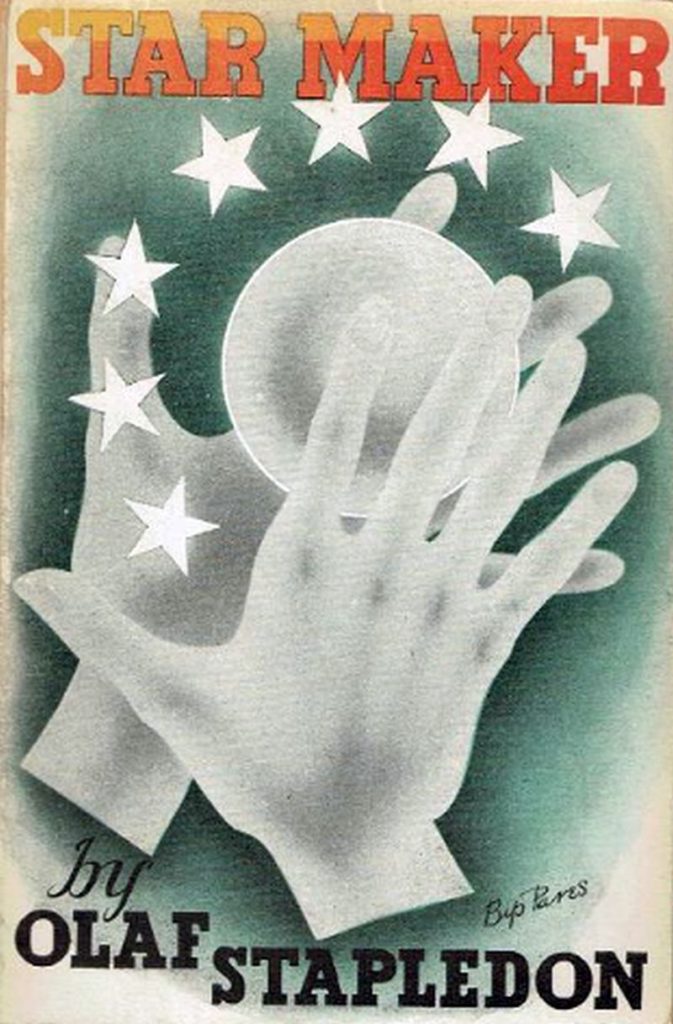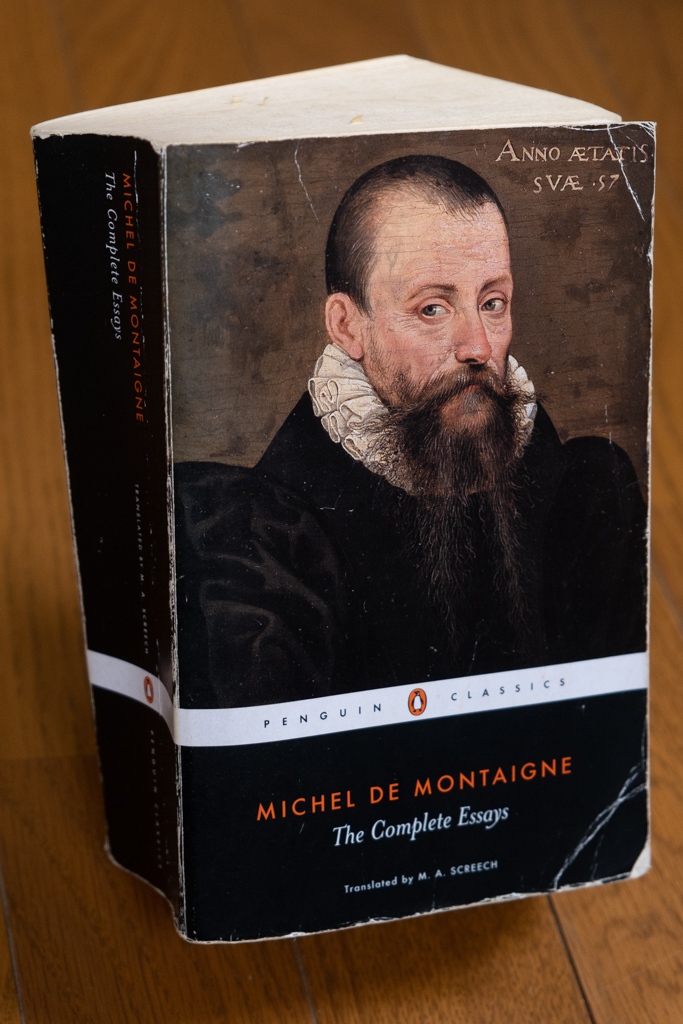book review by Eli K.P. William
Olaf Stapledon, a central figure in the early history of science fiction, was a philosopher by training but is best known for two novels, Last and First Men (1930) and Star Maker (1937). Both are renowned for their depictions of vast spans of future history.
Storytelling Across Deep Time
Last and First Men tells the saga of the human species, from early 21st century modernity, through posthuman settlement of the solar system, to our extinction. Skipping over aeons from one page to the next, the story covers some 2 billion years.
But even the enormous scope of this narrative is little more than a blip on the dizzying timescale of Star Maker. Stapledon provides three timescales at the back of the book (I read the Faded Page e-book edition that is public domain in Canada and elsewhere). These simple diagrams distill the often meandering plot into chronological form and help the reader gather their thoughts after the overwhelming “transcosmic” odyssey recounted, making them the ideal starting point for discussing the novel as a whole.
Time Scale 1 is a vertical line running top to bottom from the age when the first stars formed to the death of the last galaxy. It is divided into ten eras of ten billion years each, suggesting that the story takes place over a period of 100 billion years!
Yet Time Scale 2, on the following page, indicates that Time Scale 1 was merely a rough accounting. More precisely speaking, the narrative encompasses the entire period from the creation of our universe to its complete “physical quiescence”, measuring some 500 billion years…
But even this mind-boggling temporal magnitude is transcended by Time Scale 3. Here a diagram reminiscent of a wheel illustrates the craft of universe creation undertaken by the god-like Star Maker, with spokes that represent the incommensurable timelines of countless universes and a hub that represents eternity itself.
Taken together, the three timescales indicate that the novel, after taking the reader across the entirety of time in our cosmos —not to mention space and the memories of all sentient minds — leaves behind time altogether.
Quest for the Star Maker
The natural question to ask here is how this could all possibly be narrated in a mere 339 pages. What sort of story is this?
Star Maker begins with an unnamed Englishman, our narrator and protagonist, who is contemplating his relationship with his wife and the fraught era in which he lives. The novel was published in 1937, so presumably it was composed in the mid 1930s, the nadir of the Great Depression and the apex of Nazi fervour. These ominous historical trends are only occasionally mentioned, but they colour the novel’s outlook and play an important role in the denouement.
After gazing at the English scenery from a hillside while lost in thought, the consciousness of the protagonist leaves his body and begins to fly through space. The following chapters are reminiscent of accounts of astral projection, remote viewing, and OBEs. In a sort of psychedelic fugue, the man meanders across our solar system and launches off into the galaxy.
The descriptions of the cosmos here are a testament to Stapledon’s power of imagination and extrapolation. A detailed analysis would certainly reveal minor inaccuracies. But despite the limited astronomical knowledge available in the 1930s and the fact that humankind had yet to leave the planet Earth, his vision of what it would be like to visit outer space feels surprisingly plausible to a laymen reader in the 21st century.
Stars appear to turn blueish when the protagonist accelerates and reddish when he slows down, demonstrating Stapledon’s familiarity with the “blue shift”, a phenomenon still central to astronomy today. In addition to physics, Stapledon reveals over the course of the novel his polymathic grasp of numerous fields, from cosmology to politics, biology to theology.
The protagonist soon finds himself on a distant planet called the Other Earth. There live the Other Men, an alien species similar to homo sapiens, except that their features and physique are arranged differently and their dominant sense is smell rather than vision.
Our protagonist discovers that he can inhabit the consciousness of these beings and communicate with his mental hosts telepathically. Eventually, he settles in the mind of a renegade philosopher named Bvalltu, who welcomes this psychic interloper. By inhabiting numerous minds and engaging in dialogue with Bvalltu, the protagonist learns first-person about the intricacies of the Other Earth’s civilization, including their experience-transmitting radio systems used for entertainment and propaganda.
When Bvalltu learns how to leave his body as well, the two comrades begin to soar through the cosmos together. Soon they find themselves uniting in a strange synthesis of consciousness in which their individuality remains intact and yet they become a dual mind that is greater than the sum of its mental parts.
We learn that there are other psychic wanderers of the void. All tend to be drawn to beings whose consciousness is similar to their own, which is why our protagonist had ended up on the Other Earth. In their travels, he and Bvalltu encounter many minds like theirs. When these add their consciousnesses to the mix, they all swell into a sort of itinerant agglomeration of souls able to traverse space and time with ease.
The goal of this emergent spiritual being is to reach ever higher levels of awareness through inhabiting and absorbing ever more diverse alien perspectives and their associated memories from across the ages and regions of the universe. Through this phenomenological field work, it hopes to attain percipience worthy of a meeting with the titular Star Maker, a mysterious being who may or may not exist and who may or may not have created the cosmos. By solving the puzzle of the Star Maker, the multitudinous being might uncover the purpose, value, and meaning of existence, if any.
Infowasteland or Tale of Individual Transcendence?
Already in the Other Earth chapters, descriptions of the protagonist’s immediate experience have fallen away in favour of dense exposition. Now, as the protagonist’s individuality dissolves into a larger plurality, Stapledon gives up on any pretence of depicting drama or the actions of particular characters. Bvalltu, for example, is at this point entirely forgotten and never returns to the narrative in any significant way.
In the creative-writing-program-speak prevalent today, the story is all telling, no showing, and an uncharitable reader might dismiss the novel as one ginoromous infodump—an infowasteland if you will. Indeed, by the standards of a traditional literary aesthetic, that favours drama and action, Star Maker is sorely deficient.
But before arriving at such hasty assessments, we ought to remember the author’s project: Stapledon is here attempting to depict the history of the cosmos across deep time and to even dip into the viewpoint of eternity. It is unreasonable to expect him to simultaneously delve into the day-to- day specifics of individual characters and their relationships within the word count of a regular novel. He would have had to write a novel ten times the length—indeed, perhaps, a whole series.
And there is no guarantee, for all that narrative renovation, that the novel would have been any better. Rather, attending excessively to characters in specific times and places would have been incompatible with the plot of confronting the Star Maker, which presupposes transcendence of both individuality and space-time through an ever wider and more variegated experiential understanding of the cosmos.
World, Galactic, and Cosmic Spirits
As our bundle of consciousnesses swells and grows ever more diverse, the flavour of the minds for which it has affinity begins to broaden, drawing it to worlds with beings ever more different from the homo sapiens we began with. As with the Other Earth, the reader begins to learn in detail of the formation and histories of manifold alien beings. These include Echinoderms, humanoids evolved from starfish, Nautiloids, molluscs that evolved into biological boats, and stranger creatures besides.
Under the novel’s incredibly inclusive way of thinking, all of these organisms are a variety of “mankind.” To the question of whether some being is a “man”—or what in present discourse we might call a “human” or “person”—bodily shape, physiology, and biology are all irrelevant. Instead, man’s defining feature wherever he might be found in the cosmos is the attainment of a certain level of spiritual or mental development.
However distinct the histories of each mankind may be in detail, we learn that they all follow a similar cycle of technological progress and spiritual crisis. Most mankinds fail to survive this crisis, and fade into misery and cataclysm. But some manage to form into “world spirits”, which transcend and include the minds of each being on the planet, becoming a united but multiple planetary mind. These planetary minds, in turn, often meet an ignominious or unfortunate end, but the cream are able to create utopias of near perfect wisdom and goodness.
Once these world spirits begin to engage in federation and imperial expansion across their galaxy, many are lost to conflict. But some form together into even greater “galactic spirits.” Our protagonist dips into the minds of these world and galactic spirits in his ongoing exploration of the universe and its psyche.
Eventually he inhabits the minds of stars and nebulae, absorbing their slow, elemental experiential histories that stretch for aeons upon aeons. The grand aspiration of the protagonist and those like him is to become a “cosmic spirit,” a mind that in some sense encompasses the entire cosmos.
When the protagonist at last confronts the Star Maker, the experience so far transcends his individual human mind that he is unable to adequately express it in language. Thus, the account the reader has been given, as the narrator frequently reminds us, is at best an interpretation or vague approximation of something ineffable that no human could ever comprehend.
The eponymous Star Maker is revealed to be (SPOILER ALERT!) not an almighty God with a definitive a priori plan, but a flawed cosmogenetic experimentalist. That is, he creates cosmos after cosmos through a process of trial and error, testing and scrapping ever better approximations of his ideal cosmos. Our universe is merely one of countless failed experiments.
Philosophical Denouement
Stapledon’s expertise in philosophy emerges frequently throughout the novel. Whole academic treatises could surely be written on its theoretical underpinnings. Here I’ll note only the two most obvious philosophers alluded to.
The first is the German philosopher Hegel. The description of various spirits reaching ever higher levels of transcendent realization was surely inspired by Hegel’s historical idealism, which was still highly influential in the 1930s, if losing adherents to then ascendent Marxist and logical positivist movements.
The second is Leibniz. Explicitly mentioned twice in the novel is his idea of “pre-established harmony.” By this Leibniz referred to the supposed perfection God had imbued our universe with from its inception, such that any apparent evil or defects only reveal our human inability to grasp the divine plan.
In the final chapter, with the protagonist’s return to England, Earth, the novel even arrives at a sort of philosophical conclusion: in spite of the apparent triviality of Earthly troubles in comparison to the majestic progression of the cosmos across deep time and the transcendent cosmic factory of the Star Maker, our individual lives nevertheless have meaning and we should continue to fight for the sake of justice in the present.
In this final lesson, we can sense Stapledon’s own concerns about the impending threat of what would come to be known as World War II, set to erupt in only a few short years (or, according to some historical reckonings, already begun.)
Those seeking drama, action, and well-realized characters should look elsewhere. But for those who think deeply about the mysteries of the cosmos and the meaning of human life, Star Maker is a much-needed salve to our existential puzzlement.

Book review by Eli K.P. William.
I am the author of three dystopian sci-fi novels: Cash Crash Jubilee, The Naked World, and A Diamond Dream. I also translate Japanese literature, including the bestselling novel A Man, by Keiichiro Hirano.
More about me here.
My Twitter: @Dice_Carver

